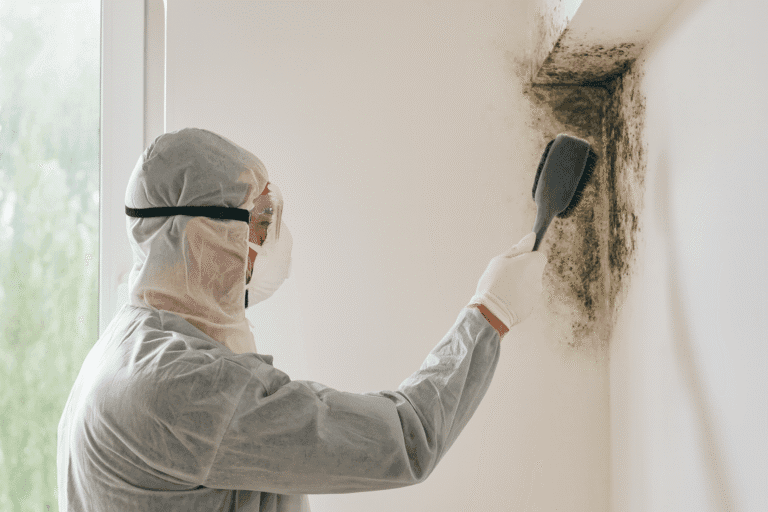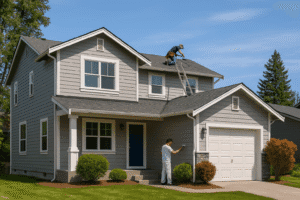Yes, you can sell a house with mold. Most buyers and lenders will expect proof that the moisture source was fixed and the mold was properly remediated — otherwise they’ll ask for repair credits or a price reduction. If time, budget, or scope makes repairs tough, you can sell as-is for cash and let the buyer handle remediation after closing.
Need a fast, clean sale (even with mold)? Get a no-obligation cash offer from Orca Homes
What Counts as “Mold” — And Why Buyers Care
Mold is a fungus that grows wherever moisture meets organic material, like drywall paper, wood framing, carpet padding, or insulation. It’s common in humid or poorly ventilated areas such as bathrooms, basements, crawl spaces, and attics. While not all mold is dangerous, it’s always a red flag for buyers because it points to past or ongoing moisture problems.
There are three main categories of mold you might encounter:
- Allergenic molds: Usually mild but can trigger allergies or respiratory discomfort.
- Pathogenic molds: Riskier for people with weakened immune systems.
- Toxigenic molds: The most serious, as they produce harmful mycotoxins that can affect both humans and pets.
For potential buyers, mold raises two major concerns:
- Health risks — issues like poor air quality, allergies, or asthma flare-ups.
- Structural risks — moisture intrusion that can weaken wood framing, drywall, or flooring over time.
Buyers want clear evidence that the moisture source has been repaired and that any affected materials were professionally remediated — or they’ll expect a lower price to cover those costs.

Step-by-Step: Fix It Fast (So You Don’t Lose Buyers)
When it comes to selling a house with mold, time matters. The faster you can show buyers (and their inspectors) that the issue was handled properly, the less likely you’ll face low offers or deal cancellations. Follow these five steps to fix the problem efficiently — and document everything for peace of mind.
1.Stop the water
Find and fix the moisture source first — whether it’s a leaky pipe, roof, or poor ventilation. Improve airflow in humid rooms and use dehumidifiers to keep indoor humidity below 50%.
2. Contain + remove
Seal off affected areas with plastic barriers, cut out contaminated drywall or insulation, and use HEPA vacuums to remove spores. Always discard infected materials safely to prevent cross-contamination.
3. Dry to spec
Run air movers and dehumidifiers until all materials (walls, framing, subfloors) reach safe moisture levels verified with a moisture meter. This ensures the mold won’t return once you rebuild.
4. Treat + rebuild
Apply an antimicrobial treatment to exposed surfaces and replace damaged materials with dry, mold-resistant products. Repaint or refinish using mildew-resistant coatings in high-humidity areas.
5 .Document everything
Keep detailed before-and-after photos, invoices, moisture readings, and warranties from any remediation contractors. Buyers (and lenders) love seeing clear proof that the work was handled professionally.
Pro Tip: If you’re on a tight listing timeline, prioritize fixing the source of the problem and cleaning high-visibility areas like bathrooms, laundry rooms, basement corners, and attic sheathing above bathrooms. These are the spots most likely to be flagged during an inspection.
Your Options When Selling a House With Mold
You have several paths when selling a home with mold, depending on your budget, timeline, and how much work you want to take on. Each option comes with trade-offs in speed, price, and buyer appeal.
1) Remediate Before Listing (Maximize Value)
Pros: Strongest offers, easier financing, fewer inspection surprises.
Cons: Takes time and money. Typical remediation costs range from $1,500–$6,000+ for small-to-moderate areas, and $4,000–$12,000+ for large spaces like attics or crawl spaces.
If your goal is top dollar, professional remediation pays off. You’ll attract more traditional buyers and avoid lender issues that can derail a sale.
2) Offer a Repair Credit
Pros: Faster to market; lets buyers choose their own contractor.
Cons: Still affects your bottom line — and some lenders won’t approve funding until mold is resolved.
A credit can be smart if you want to keep momentum but don’t have time to manage the work yourself. Just make sure your disclosure and documentation are clear to protect yourself legally.
3) Price It to Move
Pros: Draws investors and DIY-minded buyers quickly.
Cons: Lower sale price; still might encounter financing hurdles for standard buyers.
Pricing your property below market can offset buyer concerns and speed up the process. However, expect some buyers to request additional concessions once inspections begin.
4) Sell As-Is for Cash
Pros: No repairs, no showings, no lender delays — close in as little as 7–21 days.
Cons: Lower offer compared to a fully remediated, retail-ready sale.
Selling as-is to a cash home buyer eliminates all the stress of cleanup, financing, and inspection negotiations. You trade a bit of price for maximum convenience and certainty.
Considering an as-is sale? Read our guide: Should I Sell My House for Cash?
Disclosures: Be 100% Transparent
When selling a house with mold, honesty is non-negotiable. You’re legally required to disclose any known mold or water issues — past or present — and the steps you’ve taken to address them. Most buyers won’t walk away from a mold issue if they trust the documentation and transparency.
Here’s what to include in your disclosure package:
- Receipts for any roof, plumbing, HVAC, or ventilation repairs.
- Remediation scope reports and clearance letters from certified contractors.
- Photos showing before, during, and after cleanup.
- Notes on moisture prevention — things like bath fans, upgraded gutters, slope grading, or installed dehumidifiers.
Being upfront builds credibility and can protect you from future legal claims.
Related: Home-Buying Scams to Avoid — smart reading before accepting quick “we buy houses” offers.
Pricing: How Mold Affects Market Value
Mold doesn’t automatically ruin a sale — but it does influence price, depending on whether the issue has been handled.
- Remediated + documented: Smallest hit, sometimes negligible if the work was professional and certified.
- Unremediated but credited: Expect a discount roughly equal to the estimated remediation cost plus a risk buffer for the buyer.
- As-is cash sale: Larger discount, but often offset by speed, simplicity, and certainty — especially if you’re facing deadlines or financial stress.
To price confidently, pair your listing with a fresh comparative market analysis (CMA) and, if possible, a pre-listing inspection focused on moisture-prone areas (bathrooms, crawl spaces, basements, attics). This helps minimize renegotiations later.
See also: What Is the Market Value of My Home?
Common Mistakes to Avoid
Even experienced homeowners make costly errors when trying to sell a house with mold. Avoid these common missteps to protect your sale price — and your peace of mind:
- Cleaning the spot but not fixing the source: Mold will return if moisture problems (like leaks or poor ventilation) remain unresolved.
- DIY beyond 10 sq. ft. without containment: Anything larger than a small patch can spread spores throughout your home and make the issue worse.
- Skipping documentation: Buyers and lenders won’t accept verbal assurances. Keep written proof of remediation and repairs.
- Hiding the issue: Concealment kills trust and can create serious legal exposure after closing.
- Pricing like nothing happened: Ignoring the issue leads to appraisal problems and buyer re-negotiations. Price realistically based on condition and documentation.
Selling As-Is for Cash (When Speed or Certainty Matters)
Sometimes, fixing or waiting just isn’t worth it — and that’s okay. If you need to move quickly or avoid repairs, selling your house as-is for cash can be the best solution.
- No repairs or showings — buyers purchase the home in its current condition.
- Fewer contingencies — cash buyers skip traditional financing and inspection delays.
- Title and escrow handle all paperwork, ensuring liens, disclosures, and transfers are done correctly.
- You choose the close date, often within 7–21 days.
This route is ideal if you’re short on time, low on funds, or simply want a guaranteed exit without worrying about inspections or appraisals.
Skip the headaches — get a cash offer from Orca Homes and move on at your pace.
Final Word
Selling a house with mold is completely manageable — even if it feels overwhelming at first. The key is to fix the source of moisture, remediate properly, document everything, and be transparent with buyers. Whether you decide to handle repairs and list traditionally or go for a fast, as-is cash sale, there’s always a path forward.
Ready to move on? Orca Homes buys houses as-is — fast, fair, and private.
FAQs: Selling a House With Mold
Can you sell a house with mold?
Yes. You can still sell your home — just choose the right strategy: remediate before listing, offer a repair credit, price it accordingly, or sell as-is for cash if you need a quick, guaranteed sale.
What if mold comes back before closing?
Act fast. Re-address the source, re-mediate, and update your documentation to keep the deal on track. Buyers and lenders respond best when you show immediate, verifiable action.
What’s safest as a seller on a deadline?
An as-is cash sale or a repair credit with a flexible closing date. Selling for cash provides the most certainty and speed, especially when time or financing hurdles are a concern.
Does mold lower a home’s value?
Yes, usually — but how much depends on severity and documentation. A remediated and certified clean home may only see a small value hit, while untreated or hidden mold can lower offers by 5–20% depending on scope and location.
Is it illegal to sell a house with mold?
No, but you must disclose any known mold or water issues. Concealing a mold problem can lead to legal action or rescission of the sale. Transparency with photos and receipts builds buyer trust and protects you.



